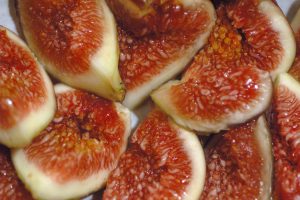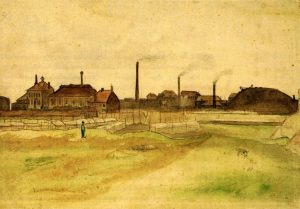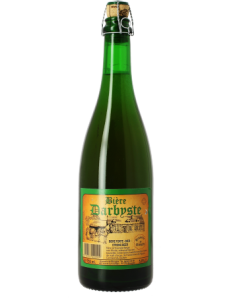Fig beer from the Borinage region
 A while ago I made a study of the Belgian beer style saison, and in connection with that, the historical beers of the Walloon countryside. As it turned out, there wasn’t much connection to begin with: although the current reference beer for saison, the Saison Dupont, does hail from the countryside of Hainaut, the beer type saison once was found in a much wider area including in cities, especially Liège. Unfortunately, the history of saison as compiled by renowned Brussels brewer Yvan de Baets in the book Farmhouse ales, turned out to contain a substantial amount of half-truths and selective reading. Too bad, really.
A while ago I made a study of the Belgian beer style saison, and in connection with that, the historical beers of the Walloon countryside. As it turned out, there wasn’t much connection to begin with: although the current reference beer for saison, the Saison Dupont, does hail from the countryside of Hainaut, the beer type saison once was found in a much wider area including in cities, especially Liège. Unfortunately, the history of saison as compiled by renowned Brussels brewer Yvan de Baets in the book Farmhouse ales, turned out to contain a substantial amount of half-truths and selective reading. Too bad, really.
So what was the real deal with rural beers in Wallonia? We don’t know all that much about the beers brewed for personal consumption on farms and at people’s homes. One interesting article that I reviewed previously, by one Roger Pinon, did provide some recipes recorded by various people throughout the 20th century, but all of these recipes were relatively new, and none of them were for actual beer.[1] In the early 20th century, probably especially around the First World War, when many breweries were forced to close, there was a trend in Belgium and Northern France to brew ‘beer’ at home, mainly with sugar. They would make something that resembled a tea with the taste of barley, hops, chicory and other flavourings, then added a substantial amount of sugar, they added yeast and voilà: the sugar water fermented into a simple alcoholic beverage, that invariably was put in bottles and could be kept for a couple of weeks.
 However, Pinon described an interesting subcategory, that merits an additional looking into: fig beer. This was mainly made in the Borinage, a coal mining region west of Mons, near the French border. During the 19th and early 20th centuries, working conditions here were far from light, which turned the region into a hotbed of socialist revolt. And of Protestantism, in an otherwise devoutly catholic country like Belgium. Even protestant minister’s son Vincent van Gogh did some evangelizing here, before he decided to devote himself to the arts.
However, Pinon described an interesting subcategory, that merits an additional looking into: fig beer. This was mainly made in the Borinage, a coal mining region west of Mons, near the French border. During the 19th and early 20th centuries, working conditions here were far from light, which turned the region into a hotbed of socialist revolt. And of Protestantism, in an otherwise devoutly catholic country like Belgium. Even protestant minister’s son Vincent van Gogh did some evangelizing here, before he decided to devote himself to the arts.
It was here that people made a homebrew with figs, locally also known as ‘bière darbyste’, after a movement of deeply religious protestants, originally founded by one John Nelson Darby. Either these Christian brethren didn’t want to drink real beer and therefore produced this low-alcohol brew, or the name ‘darbyst beer’ was just invented as a funny nickname, because of its low alcohol content.
Pinon cites various recipes for this fig beer. A strikingly consistent feature is the fact that they would have the figs soak for a few days along with some barley, after which they would add no yeast. A fairly typical recipe is as follows:
Fig beer by ‘Aunt Jusa’ (M. Caufriez-Saussez from Wasmes)
Required: a big pot out of varnished earthenware.
Ingredients: 15 to 20 litres of water, half a kilogram of barley, 400 grams of figs, 1 kilogram of sugar lumps, two beaten egg whites.
Recipe: clean the barley several times and put it in the pot, add the figs and the water; close the lid. The next day, or as soon as the figs float on the surface (after one or two days, depending on the temperature), remove the fruits and throw them away. As for the barley, rinse it carefully because it can be used again. Filter the beer with a cheesecloth and put it back into the well-cleaned pot. Add the sugar and the beaten egg whites; mix well and then put the lid on again, but with a towel between the pot and the lid. The next day, remove the floating foam (‘pain d’oeuf’) with a skimmer, and put the beer in bottles by means of a funnel with a tea sieve on it. After two or three days the beer is ready to drink.
Apparently, the resulting drink was quite carbonated and you had to beware of bottles exploding because of too much pressure. It was mainly made and consumed in summer and was very refreshing.
 Don’t fancy trying this out for yourself? Since 1990, the small family-owned Brasserie de Blaugies in the Borinage village with the same name makes its own ‘Bière Darbyste’ with figs. This version actually is a real beer, made from barley malt and wheat, to which fig juice is added. At 5.8% ABV it is also a lot heavier than the original fig beer must have been.
Don’t fancy trying this out for yourself? Since 1990, the small family-owned Brasserie de Blaugies in the Borinage village with the same name makes its own ‘Bière Darbyste’ with figs. This version actually is a real beer, made from barley malt and wheat, to which fig juice is added. At 5.8% ABV it is also a lot heavier than the original fig beer must have been.
[1] Roger Pinon, ‘Recettes de bières de ménage en Wallonie et subsidiairement en Picardie’, in: Studium et museum. Mélanges Edouard Remouchamps, volume I, Liège 1996, p. 103-122.






Great to have some more informations on this beverage !
Yes saison beers as we knoe them today are just half the truth and fairy tales.